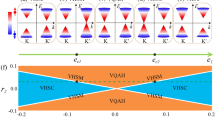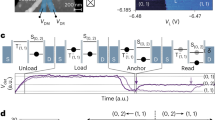Abstract
The field of ‘Valleytronics’ has recently been attracting growing interest as a promising concept for the next generation electronics, because non-dissipative pure valley currents with no accompanying net charge flow can be manipulated for computational use, akin to pure spin currents1. Valley is a quantum number defined in an electronic system whose energy bands contain energetically degenerate but non-equivalent local minima (conduction band) or maxima (valence band) due to a certain crystal structure. Specifically, spatial inversion symmetry broken two-dimensional honeycomb lattice systems exhibiting Berry curvature is a subset of possible systems that enable optical2,3,4,5, magnetic6,7,8,9 and electrical control of the valley degree of freedom10,11,12. Here we use dual-gated bilayer graphene to electrically induce and control broken inversion symmetry (or Berry curvature) as well as the carrier density for generating and detecting the pure valley current. In the insulating regime, at zero-magnetic field, we observe a large nonlocal resistance that scales cubically with the local resistivity, which is evidence of pure valley current.
This is a preview of subscription content, access via your institution
Access options
Subscribe to this journal
Receive 12 print issues and online access
$259.00 per year
only $21.58 per issue
Buy this article
- Purchase on SpringerLink
- Instant access to full article PDF
Prices may be subject to local taxes which are calculated during checkout




Similar content being viewed by others
References
Jungwirth, T., Wunderlich, J. & Olejník, K. Spin Hall effect devices. Nature Mater. 11, 382–390 (2012).
Yao, W., Xiao, D. & Niu, Q. Valley-dependent optoelectronics from inversion symmetry breaking. Phys. Rev. B 77, 235406 (2008).
Cao, T. et al. Valley-selective circular dichroism of monolayer molybdenum disulphide. Nature Commun. 3, 887 (2012).
Zeng, H., Dai, J., Yao, W., Xiao, D. & Cui, X. Valley polarization in MoS2 monolayers by optical pumping. Nature Nanotech. 7, 490–493 (2012).
Mak, K. F., He, K., Shan, J. & Heinz, T. F. Control of valley polarization in monolayer MoS2 by optical helicity. Nature Nanotech. 7, 494–498 (2012).
Li, Y. et al. Valley splitting and polarization by the Zeeman effect in monolayer MoSe2 . Phys. Rev. Lett. 113, 266804 (2014).
MacNeill, D. et al. Breaking of valley degeneracy by magnetic field in monolayer MoSe2 . Phys. Rev. Lett. 114, 037401 (2015).
Srivastava, A. et al. Valley Zeeman effect in elementary optical excitations of monolayer WSe2 . Nature Phys. 11, 141–147 (2015).
Aivazian, G. et al. Magnetic control of valley pseudospin in monolayer WSe2 . Nature Phys. 11, 148–152 (2015).
Xiao, D., Yao, W. & Niu, Q. Valley-contrasting physics in graphene: Magnetic moment and topological transport. Phys. Rev. Lett. 99, 236809 (2007).
Mak, K. F., McGill, K. L., Park, J. & McEuen, P. L. The valley Hall effect in MoS2 transistors. Science 344, 1489–1492 (2014).
Gorbachev, R. V. et al. Detecting topological currents in graphene superlattices. Science 346, 448–451 (2014).
Nagaosa, N., Sinova, J., Onoda, S., MacDonald, A. H. & Ong, N. P. Anomalous Hall effect. Rev. Mod. Phys. 82, 1539–1592 (2010).
Xiao, D., Chang, M.-C. & Niu, Q. Berry phase effects on electronic properties. Rev. Mod. Phys. 82, 1959–2007 (2010).
Oostinga, J. B., Heersche, H. B., Liu, X., Morpurgo, A. F. & Vandersypen, L. M. K. Gate-induced insulating state in bilayer graphene devices. Nature Mater. 7, 151–157 (2007).
Zhang, Y. et al. Direct observation of a widely tunable bandgap in bilayer graphene. Nature 459, 820–823 (2009).
Zou, K. & Zhu, J. Transport in gapped bilayer graphene: The role of potential fluctuations. Phys. Rev. B 82, 081407 (2010).
Taychatanapat, T. & Jarillo-Herrero, P. Electronic transport in dual-gated bilayer graphene at large displacement fields. Phys. Rev. Lett. 105, 166601 (2010).
Yan, J. & Fuhrer, M. S. Charge transport in dual gated bilayer graphene with Corbino geometry. Nano Lett. 10, 4521–4525 (2010).
Koshino, M. Electronic transport in bilayer graphene. New J. Phys. 11, 095010 (2009).
Zhang, F., Jung, J., Fiete, G. A., Niu, Q. & MacDonald, A. H. Spontaneous quantum Hall states in chirally stacked few-layer graphene systems. Phys. Rev. Lett. 106, 156801 (2011).
Valenzuela, S. O. & Tinkham, M. Direct electronic measurement of the spin Hall effect. Nature 442, 176–179 (2006).
Abanin, D. A., Shytov, A. V., Levitov, L. S. & Halperin, B. I. Nonlocal charge transport mediated by spin diffusion in the spin Hall effect regime. Phys. Rev. B 79, 035304 (2009).
Brüne, C. et al. Evidence for the ballistic intrinsic spin Hall effect in HgTe nanostructures. Nature Phys. 6, 448–454 (2010).
Abanin, D. A. et al. Giant nonlocality near the Dirac point in graphene. Science 332, 328–330 (2011).
Balakrishnan, J., Koon, G. K. W., Jaiswal, M., Neto, A. H. C. & Özyilmaz, B. Colossal enhancement of spin–orbit coupling in weakly hydrogenated graphene. Nature Phys. 9, 284–287 (2013).
Dean, C. R. et al. Boron nitride substrates for high-quality graphene electronics. Nature Nanotech. 5, 722–726 (2010).
Ohta, T., Bostwick, A., Seyller, T., Horn, K. & Rotenberg, E. Controlling the electronic structure of bilayer graphene. Science 313, 951–954 (2006).
Tikhonenko, F. V., Horsell, D. W., Gorbachev, R. V. & Savchenko, A. K. Weak localization in graphene flakes. Phys. Rev. Lett. 100, 056802 (2008).
Lensky, Y. D., Song, J. C. W., Samutpraphoot, P. & Levitov, L. S. Topological valley currents in gapped Dirac materials. Phys. Rev. Lett. 114, 256601 (2015).
Li, J., Martin, I., Büttiker, M. & Morpurgo, A. F. Topological origin of subgap conductance in insulating bilayer graphene. Nature Phys. 7, 38–42 (2010).
Ju, L. et al. Topological valley transport at bilayer graphene domain walls. Nature 520, 650–655 (2015).
Sui, M. et al. Gate-tunable topological valley transport in bilayer graphene. Nature Phys. http://dx.doi.org/10.1038/nphys3485 (2015).
Taychatanapat, T., Watanabe, K., Taniguchi, T. & Jarillo-Herrero, P. Quantum Hall effect and Landau-level crossing of Dirac fermions in trilayer graphene. Nature Phys. 7, 621–625 (2011).
Jalilian, R. et al. Scanning gate microscopy on graphene: Charge inhomogeneity and extrinsic doping. Nanotechnology 22, 295705 (2011).
Goossens, A. M. et al. Mechanical cleaning of graphene. Appl. Phys. Lett. 100, 073110 (2012).
Lindvall, N., Kalabukhov, A. & Yurgens, A. Cleaning graphene using atomic force microscope. J. Appl. Phys. 111, 064904 (2012).
Acknowledgements
We acknowledge fruitful discussion with L. S. Levitov, J. C. W. Song, M. Koshino, M. Ezawa and N. Nagaosa. Y.S. acknowledges support from Japan Society for the Promotion of Science (JSPS) Research Fellowship for Young Scientists and JSPS Program for Leading Graduate Schools (MERIT). M.Y., K.W. and T.T. acknowledge support from JSPS Grant-in-Aid for Scientific Research on Innovative Areas ‘Science of Atomic Layers’. M.Y. acknowledges support from Canon Foundation. I.V.B. acknowledges support from JSPS International Research Fellowship. K.W. and T.T. acknowledge support from the Elemental Strategy Initiative conducted by the MEXT, Japan. T.T. acknowledges support from JSPS Grant-in-Aid for Scientific Research A (No. 26248061) and JSPS Innovative Areas ‘Nano Informatics’ (No. 25106006). S.T. acknowledges support from DFG-JST joint research project ‘Topological Electronics’ and JSPS Grant-in-Aid for Scientific Research S (No. 26220710).
Author information
Authors and Affiliations
Contributions
Y.S. conceived the experiment, designed the experiment with M.Y., fabricated the samples, conducted measurements and analysis, interpreted the data with M.Y., and wrote the manuscript with M.Y., I.V.B. and S.T. I.V.B. contributed to the measurements. T.T. and K.W. synthesized h-BN samples. M.Y. and S.T. directed the research. All authors discussed the results and the manuscript.
Corresponding authors
Ethics declarations
Competing interests
The authors declare no competing financial interests.
Supplementary information
Supplementary information
Supplementary information (PDF 3160 kb)
Rights and permissions
About this article
Cite this article
Shimazaki, Y., Yamamoto, M., Borzenets, I. et al. Generation and detection of pure valley current by electrically induced Berry curvature in bilayer graphene. Nature Phys 11, 1032–1036 (2015). https://doi.org/10.1038/nphys3551
Received:
Accepted:
Published:
Issue date:
DOI: https://doi.org/10.1038/nphys3551
This article is cited by
-
Inheritance of the exciton geometric structure from Bloch electrons in two-dimensional layered semiconductors
Frontiers of Physics (2024)
-
Quantized valley Hall response from local bulk density variations
Communications Physics (2023)
-
Strain engineering of electronic properties and anomalous valley hall conductivity of transition metal dichalcogenide nanoribbons
Scientific Reports (2022)
-
Robust all-electrical topological valley filtering using monolayer 2D-Xenes
npj 2D Materials and Applications (2022)
-
Long-range nontopological edge currents in charge-neutral graphene
Nature (2021)



